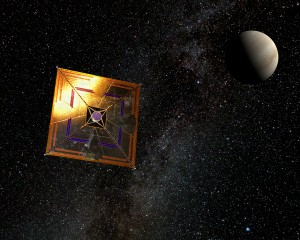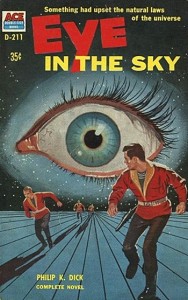No Visitors: A Non-Silly ETH for Our Silly Times
“At present, utilizing the principal of parsimony, my ‘investigative assumption’ is … that we are dealing with extraterrestrial visitations as the central core of the problem.” Jim Lorenzen
“The evidence is overwhelming that the Earth is being visited by intelligently controlled vehicles from off the Earth.” Stanton Friedman
“I believe that these extra-terrestrial vehicles and their crews are visiting this planet from other planets.” Gordon Cooper
The extraterrestrial hypothesis or ETH was a natural deduction for mid-20th-century observers of the UFO phenomenon, including respectable military folks and astronauts like Gordon Cooper who, in the same breath as acknowledging flying saucers’ reality, stated confidently that these were ships crewed by beings from other planets. The science and science-fiction of that era made such a hypothesis inevitable. But while science has moved on, that retro sci-fi vision has proven maddeningly durable; to this day, the public hears “UFO” and still sees in their mind’s eye a spaceship with an extraterrestrial pilot behind the wheel … possibly crashing and dying in the American desert. Over time, the sensible enough ETH became the ETA, the extraterrestrial assumption, which is, unfortunately, no longer quite so sensible.
 The ETA has harmed ufology not only by limiting people’s imaginations but also by making it easy for skeptics to parody the whole UFO topic or reduce it to a facile either/or: Either they are little green (or gray) men from other planets flying thousands of light years to get here in little rickety ships or they are just a figment of overactive imaginations. The absurdity of the former picture has driven many smart people into the latter position by default, not realizing there is actually a large and interesting gray area (get it?—gray area?) filled with a veritable zoo of different scientifically plausible possibilities, which writers from John Keel and Jacques Vallee to Mac Tonnies and lots of lesser-known folks have explored in a vast and often thoughtful literature.
The ETA has harmed ufology not only by limiting people’s imaginations but also by making it easy for skeptics to parody the whole UFO topic or reduce it to a facile either/or: Either they are little green (or gray) men from other planets flying thousands of light years to get here in little rickety ships or they are just a figment of overactive imaginations. The absurdity of the former picture has driven many smart people into the latter position by default, not realizing there is actually a large and interesting gray area (get it?—gray area?) filled with a veritable zoo of different scientifically plausible possibilities, which writers from John Keel and Jacques Vallee to Mac Tonnies and lots of lesser-known folks have explored in a vast and often thoughtful literature.
To this day, the public hears “UFO” and still sees in their mind’s eye a spaceship with an extraterrestrial pilot behind the wheel … possibly crashing and dying in the American desert.
Embedded within the simplistic ETA is a corollary that acts as an equally strong fetter on the imagination and is equally powerful ammo in the skeptic’s arsenal: the assumption that UFO encounters (if real) would represent some sort of visitation. That imaginary spaceship with the ET pilot at the steering wheel only makes sense within the context of beings who actually live somewhere else, take long treacherous journeys to our world to spy on us or study us, and intend to go home afterward. Over on UFO Conjecture(s), Rich Reynolds recently put the silliness of that idea in perspective by pointing out the spec-like insignificance of Earth in the galactic scheme of things and the true vastness of cosmic distances. We’re a backwater, he says, and for this reason, any notion of our planet and its dominant civilization being the object of active, interested, ET visitation is ludicrous.
It was partly this assumption—that ETs would be here in order to ‘visit’ us—that steered Jacques Vallee away from the extraterrestrial hypothesis back in the late 1960s: The sheer number of recorded (let alone estimated) encounters is way too many, and goes back way too long in history, to represent some Apollo-style space program of ET space missions to fly here, collect a few soil samples and rocks, get some sperm and egg cells from hapless earthlings, and then return home. It’s also worth noting that while Carl Sagan always pitched for the skeptical team, his imagination, fully on board with the existence of ETs “out there,” followed a similar logic when it came to the question of visitation: They would stop by for visit to check things out, but only every few thousand years or so. That would somehow be enough to gather the information necessary.
 It’s hard not to agree with Reynolds: ET visitation is ludicrous. But I also think the ET hypothesis (not assumption) has a great deal of residual merit so long as we discard the whole notion of “visitation,” radically revise our notion of what we mean by “ET,” and bring our picture of possible ET motives and methods more in line with our current understanding of science, space exploration, and our own future evolution.
It’s hard not to agree with Reynolds: ET visitation is ludicrous. But I also think the ET hypothesis (not assumption) has a great deal of residual merit so long as we discard the whole notion of “visitation,” radically revise our notion of what we mean by “ET,” and bring our picture of possible ET motives and methods more in line with our current understanding of science, space exploration, and our own future evolution.
Flesh and blood beings piloting spaceships across vast light years to visit us is indeed silly—and we’d be doing ourselves a favor if we educated the wider public that that’s not what we mean by “UFOs.” On the other hand, permanently entrenched local machine proxies—drones—conducting long-term dispassionate surveillance on behalf of one or more advanced (probably very ancient) ET civilizations for both science and security purposes—or what I have called “deep anthropology”—is not nearly as silly a hypothesis. To see why, we simply need to think realistically about our own future presence in space while bearing in mind the mathematical models showing that the galaxy’s earliest civilizations should already have a presence, of some sort, throughout it.
The Real Fermi Paradox
Enrico Fermi famously asked his Los Alamos colleagues over lunch in 1950, “Where are they?” This question presupposes two things: that “they” (ETs) will have some motive to come here, and that “they” aren’t here already. It was a sensible question at the time: Mathematical sophisticates like Fermi knew that we were unlikely to be alone; and they also calculated that, even given the enormous distances that would be involved in interstellar travel and colonization, in a universe “of a certain age” (as we might say politely), we ought to be newcomers in an already loud, bustling cosmic metropolis. The various mathematical models showing that our galaxy, including our backwater, should already be colonized by the civilizations that first emerged has been taken by some as evidence that there may be something wrong with our assumptions. Indeed. I would restate the Fermi paradox as the following hypothesis: They’re here already and (paradoxically) they never left home.
 The problem is the assumption of outward travel and expansion as an inevitable or even likely path for an advanced technological species. Fragile, mortal beings have an impulse to have big families, grow, and spread, colonizing new real estate in the name of Lebensraum, “living room.” Most of recorded human history fits into such a picture, and so it was natural to project such an assumption onto our own future and, by extension, onto ET. But as countless more recent futurians and SF writers have promised, we are approaching some kind of cusp—a technological and social perfect storm that, even in its most conservative versions, will change the game in all kinds of ways that just couldn’t be envisioned or imagined 65 years ago. When you recognize that a society must evolve in tandem with its technology, that assumption of outward spread “in the flesh” looks less and less plausible.
The problem is the assumption of outward travel and expansion as an inevitable or even likely path for an advanced technological species. Fragile, mortal beings have an impulse to have big families, grow, and spread, colonizing new real estate in the name of Lebensraum, “living room.” Most of recorded human history fits into such a picture, and so it was natural to project such an assumption onto our own future and, by extension, onto ET. But as countless more recent futurians and SF writers have promised, we are approaching some kind of cusp—a technological and social perfect storm that, even in its most conservative versions, will change the game in all kinds of ways that just couldn’t be envisioned or imagined 65 years ago. When you recognize that a society must evolve in tandem with its technology, that assumption of outward spread “in the flesh” looks less and less plausible.
 Spaceflight capacity will only emerge alongside commensurate leaps in computing and robotics, and along with those, massive advances in energy production, matter manipulation (e.g., 3D printing and nanotech), and most importantly, biotechnology advances like genetic engineering and all the “-omics” of today’s cutting-edge health and medical science (e.g., genomics, proteomics, transcriptomics, etc.). Together, these bundled developments will not only tend to automate the business of space exploration but will also radically extend our lives, which will disincentivize the kinds of interstellar migration and colonization (and empire building) that Fermi’s generation had no reason to doubt and that generations of SF writers dramatized in their space operas. They made great stories, but those futures are wildly unrealistic from the standpoint of “existential futurology.”
Spaceflight capacity will only emerge alongside commensurate leaps in computing and robotics, and along with those, massive advances in energy production, matter manipulation (e.g., 3D printing and nanotech), and most importantly, biotechnology advances like genetic engineering and all the “-omics” of today’s cutting-edge health and medical science (e.g., genomics, proteomics, transcriptomics, etc.). Together, these bundled developments will not only tend to automate the business of space exploration but will also radically extend our lives, which will disincentivize the kinds of interstellar migration and colonization (and empire building) that Fermi’s generation had no reason to doubt and that generations of SF writers dramatized in their space operas. They made great stories, but those futures are wildly unrealistic from the standpoint of “existential futurology.”
Immortality will radically reduce, among other things, the family and reproduction, and thus ultimately eliminate the need to spread beyond one’s safe cozy planet or, at least, one’s radically terraformed (or Dyson-sphered) solar system.
We can already see that as longevity increases, family size dwindles. Today’s humans fortunate to live in advanced prosperous societies and to expect 80+ year lifespans don’t have as many kids as their shorter-lived ancestors did. Follow the curve: The standard old notion of human family groups spreading out across the galaxy in vast waves of colonization represents a failure to imagine the most radical (and probably, realistic) promise of the Singularity: near or total immortality via some combination of bioengineering and machine augmentation. It won’t necessarily happen by the middle of this century, as the most rapturous of the nerd rapturologists promise, but it will probably happen at least in the next. Immortality negates any vision of the future resembling our present society; it will radically reduce, among other things, the family and reproduction, and thus ultimately eliminate the need to spread beyond one’s safe cozy planet or, at least, one’s radically terraformed (or Dyson-sphered) solar system.
Consider the most sociologically rich and coherent literary vision of a far future interstellar society, Frank Herbert’s Dune series. It is highly significant that Herbert’s sprawling galactic empire required an ingenious literary contrivance—an ancient, strict prohibition on computers—to make its far-future vision plausible. Without the Butlerian Jihad, all of the dramatic and exciting aspects of the Dune universe—mortal humans traveling across space, engaging in deadly feudal politics involving matters of resource scarcity, protecting and nurturing genetic bloodlines through sex, waging bloody interplanetary war, and all the rest—would actually make no sense whatsoever. A technologically advanced far future will not look like the Dune universe, or the galactic empire of Asimov’s Foundation Trilogy, or the Star Wars universe, or the Star Trek universe. It is liable to look much more like the most ‘advanced’ (and outwardly kind of boring) cultures in Tolkien’s Lord of the Rings. This is because, besldes eliminating any need or motive for interstellar travel ‘in the flesh,’ immortality will also eliminate or redefine that prized redeeming feature of ‘mortal men doomed to die,’ namely courage.
The Future of Bravery
One of the first principles of existential futurology is that, counterintuitively, the preciousness of life increases with its length. A nasty, brutish, and short existence encourages not only having lots of babies but also risking life and limb for a better tomorrow for those babies, including sometimes getting in creaky vessels and emigrating to alien shores and uncertain futures, with the understanding that this life is just a brief painful travail on the way to an afterlife. In contrast, our very-long-lived descendents are likely to be stay-at-home types, materialist in their outlook, and extremely jealous of their safety and health, not unlike Tolkien’s elven races (or, less appealingly, Howard Hughes). Like the elves, they’ll be generally content to let lesser beings do the dirty work of exploration and adventuring on their behalf. For us, those ‘lesser beings’ will be our machines.
 Space travel, no matter how advanced, is bound to be a dangerous, boring pain in the ass. It’s hard to imagine future Galadriels and Elronds being interested in risky journeys across interstellar space in the flesh. They would really have little motive, because they could explore and interact with the cosmos, and even in a sense ‘inhabit’ it, by proxy via machine extensions of themselves—the other realistic promise of nerd rapturology. Scattering self-replicating drones (Von Neumann probes) to blanket the universe and all its worlds, future humans will bring the universe to them and never have to leave the comfort and safety of their Lothloriens and Rivendells. By “machines” and “drones” I of course don’t mean anything we might now recognize as such—these remote sensors and effectors could look organic, or luminous, or be microscopic, or invisible. Who knows. Remember Clarke’s famous technology indistinguishable from magic? That’s what I’m talking about. (And it’s also why we should really be reading Tolkien’s books as science fiction, not fantasy … but I digress.)
Space travel, no matter how advanced, is bound to be a dangerous, boring pain in the ass. It’s hard to imagine future Galadriels and Elronds being interested in risky journeys across interstellar space in the flesh. They would really have little motive, because they could explore and interact with the cosmos, and even in a sense ‘inhabit’ it, by proxy via machine extensions of themselves—the other realistic promise of nerd rapturology. Scattering self-replicating drones (Von Neumann probes) to blanket the universe and all its worlds, future humans will bring the universe to them and never have to leave the comfort and safety of their Lothloriens and Rivendells. By “machines” and “drones” I of course don’t mean anything we might now recognize as such—these remote sensors and effectors could look organic, or luminous, or be microscopic, or invisible. Who knows. Remember Clarke’s famous technology indistinguishable from magic? That’s what I’m talking about. (And it’s also why we should really be reading Tolkien’s books as science fiction, not fantasy … but I digress.)
Even just with today’s iPhone-controlled quadcopters, we are already well on the way to this kind of cyborg expansion of the self. In a century or two, swift, sensitive, powerful drones that are in some sense extensions of our bodies and minds will be exploring and touching and interacting with the wider world for us, being our roving eyes and ears and hands and feet. When we, now, via the Internet, enjoy the latest pictures and feeds from Mars rovers and deep-sea robots, we are getting only the tiniest taste of what that extended sensorium will one day entail as a way of “inhabiting” other environments. With the kinds of robotic technology the next century will offer us, why would we shlep us and our families and our stuff to a shitty, crampted, uncomfortable colony on Titan, or even Mars or the Moon, when we can go all those places, virtually, even all at once (the future of multitasking)? The body and its organic needs, including its location in space, will less and less define and constrain the quality and range of our experience.
The Fermi paradox should be restated: They’re here already and (paradoxically) they never left home.
Lightspeed of course will limit the ‘immediacy’ of our connection to our remoter proxies over planetary and (especially) interstellar distances, and thus our drone eyes and hands will need to be fully autonomous AIs, making decisions for themselves, repairing and replicating themselves, and engaging not only in passive observation but also active knowledge-gathering and even experimentation. In other words, the drones we send far and wide out into the galaxy will actually be fully self-guided science platforms, patiently and relentlessly gathering data to generate rich similations back on the homeworld. These proxies will be the sleek smart descendents of Voyager or the Curiosity rover, but able to make their own decisions, although (and this is an argument too big for this article) not themselves sentient (see here for why). We will experience and inhabit the universe through that technology—no ‘visitation’ needed.
It’s a reasonable hypothesis that the same basic technological/social trajectory will apply to any technological civilization that has emerged “out there,” and thus any ET presence here will be an automated, machine-mediated presence. There would be no “visits,” because dangerous visitation across vast light years by creatures who place a great value on their lives simply makes no sense. Our advanced older relatives, cosmic patriarchs and matriarchs, won’t shlep to see us backward nobodies out here in our backwater; they’ll stay at home, like Grandma and Grandpa, preferring (if there is to be any visiting) that the youngsters come to them—perhaps through some exotic technology like wormholes … which indeed could be what some UFOs are. Apparent “visits” by such beings would, at most, be simulations or avatars, not “real presence” in the sense we-the-still-meat-bound understand it.
Deep Anthropology
If we imagine post-scarcity ET civilizations able to send out self-replicating science machines that multiply and propogate to every corner of the home galaxy, copying themselves and digging in for the long haul wherever they find interesting things happening, and we also imagine (as the mathematics dictates) that the first such civilizations will have arisen billions of years ago, then the two-plus-two-equals-four of the matter is this: ET science platforms are probably already here, and probably were here even back before we were tree shrews … maybe before we were even algae. These machines would be so advanced, we’d likely not even know they were here … except, that is, when the purpose of a specific experiment or intervention required it.
 It is crucial, in this picture, to remember that an advanced spacefaring race, including ourselves in the coming centuries, will not be limited to the kinds of sparse data collection allowed by the Apollo missions or even the Curiosity rover. Computing and robotics enable exponential increases in the amount of data a space program can collect, transmit , store, and analyze, all with a minimum of direct human involvement. And the fundamental principle of basic science—learn all you can, whether or not it has foreseeable real-world payoff—dictates that there are no desirable limits to such learning. Learning isn’t just observing, it’s conducting controlled experiments with large samples and then repeating them many times to achieve a high level of prediction and control. When resources permit and it can be totally automated, any scientific space program will attempt to “know all that is knowable,” like V’ger in Star Trek: The Motion Picture, ignoring the question of application. This generates what is nowadays being called “big data.”
It is crucial, in this picture, to remember that an advanced spacefaring race, including ourselves in the coming centuries, will not be limited to the kinds of sparse data collection allowed by the Apollo missions or even the Curiosity rover. Computing and robotics enable exponential increases in the amount of data a space program can collect, transmit , store, and analyze, all with a minimum of direct human involvement. And the fundamental principle of basic science—learn all you can, whether or not it has foreseeable real-world payoff—dictates that there are no desirable limits to such learning. Learning isn’t just observing, it’s conducting controlled experiments with large samples and then repeating them many times to achieve a high level of prediction and control. When resources permit and it can be totally automated, any scientific space program will attempt to “know all that is knowable,” like V’ger in Star Trek: The Motion Picture, ignoring the question of application. This generates what is nowadays being called “big data.”
If we imagine post-scarcity ET civilizations able to send out self-replicating science machines to every corner of the home galaxy, then those machines are probably already here, and probably were here even back before we were tree shrews … maybe before we were even algae.
I argued a couple years ago on this blog that the “thin-slicing” notion of science implicit in Vallee’s important 1989 paper arguing against the ETH is not only rendered obsolete by the leaps in computing and robotics of the two and a half decades since then but also rendered unrealistic by the ways actual social science and psychology are conducted. To produce valid and useful results, any study of us by an extraterrestrial entity (machine or otherwise) would have to be an active, open-ended, longitudinal experimentation project not unlike the scenarios that unfold in psychology laboratories on any university campus, although on an immeasurably vaster scale: bizarre interactions designed to test oddball hypotheses, conducted with large enough samples of people to yield statistically significant results (along with equally large control groups for comparison), and then repeated with other pristine samples to replicate the findings, and then followed up with different permutations of the experiment (and new control groups) to test different hypotheses that emerge, and so on, ad infinitum.
 When you revise your picture of ‘ET Earthology’ as a massive, mostly stealthy, and truly neverending psychology project conducted by artificially intelligent but unsentient science machines, who never get bored and are programmed to know all that is knowable—including achieving a high degree of predictive power over the collective and individual behavior of an unpredictable and continually evolving intelligent species—then the millions of “landings” in history start to look less and less excessive. Indeed, it all starts to look very much like the “control system” Vallee himself postulated. Without meaning to, I think it is Vallee, with his most nuanced understanding of the UFO phenomenon, who gives the most support to the basic hypothesis he saw his own work as challenging: a plausible ET origin for at least a portion of the millions of UFO encounters down through the ages.
When you revise your picture of ‘ET Earthology’ as a massive, mostly stealthy, and truly neverending psychology project conducted by artificially intelligent but unsentient science machines, who never get bored and are programmed to know all that is knowable—including achieving a high degree of predictive power over the collective and individual behavior of an unpredictable and continually evolving intelligent species—then the millions of “landings” in history start to look less and less excessive. Indeed, it all starts to look very much like the “control system” Vallee himself postulated. Without meaning to, I think it is Vallee, with his most nuanced understanding of the UFO phenomenon, who gives the most support to the basic hypothesis he saw his own work as challenging: a plausible ET origin for at least a portion of the millions of UFO encounters down through the ages.
In the Noöverse, No One Gives a S***
Via Von Neumann machines, an automated and autonomous program of “knowing all that is knowable” can scour the star systems and planets of the universe without the expenditure of any of Lothlorien’s or Rivendell’s resources and without any mental effort or care on the part of its inhabitants (if they are even still alive after all this time). Thus, we shouldn’t feel special: Even if Earth is under a microscope (or a million microscopes), so is every other planet out there, probably even the ones with nothing more interesting going on than tree shrews and algae. Maybe even all the asteroid belts and Oort clouds have probes patiently scouring and mapping every slowly tumbling chunk of dust and ice.
Our advanced older relatives won’t shlep to see us out here in our backwater; they’ll stay at home, like Grandma and Grandpa, preferring (if there is to be any visiting) that the youngsters come to them.
Such a picture gives a new meaning to “known universe.” Just based on the mathematics of the matter, the universe should be fully known, multiply known, by ancient and very advanced technologies if not by the sentient beings that originally created them. We might even call it a noöverse, for this reason. (A couple of years ago I wondered if the mountains of data this would generate could be so huge that information could account for the missing mass of today’s cosmological models, somehow sequestered into the very fabric of spacetime by ancient V’gers scouring the galaxies. A reader versed in quantum computing helpfully corrected me: Information storage tends toward the miniscule; thus, whatever dark matter is, it ain’t vast and ancient servers and hard drives.)
This is hardly the only or best answer to the UFO problem, but I do think it is a more mature (and interesting) version of the ETH that is at least plausible both exo-technologically and exo-sociologically and thus worthy of putting forward for consideration and debate alongside the various contending (and equally meritorious) anti-ETH contenders, including the interdimensional (Vallee), cryptoterrestrial (Tonnies), ultraterrestrial (Keel), and various other psychological or esoteric hypotheses. It just needs to replace the easily trivialized “visiting UFO pilot” narrative that popular culture and the media (and unfortunately also some in the ufology community) still can’t seem to get past. (And no, I don’t expect the much-anticipated “Roswell Slides” are going to change my assessment; whatever is in those pictures, I doubt it is ETs.)
With all due respect to the ET visitation proponents of the past century, another part of what makes the old “UFO pilot” scenario increasingly hard to fathom today is precisely, as Reynolds said in his blog, our own smallness in our ever-widening cosmic picture: In a galaxy of 400 billion suns that probably has harbored, at times, many advanced civilizations and must be constantly teeming with astonishingly diverse flora and fauna, not to mention cool geology and exotic stellar and planetary objects of all types, it’s terribly anthropocentric to imagine that ancient eminences or their machine successors care all that much about us and our little blue planet, however Edenic we like to imagine it. Coming here is ridiculous—why bother even sending drones here? In a huge and fascinating universe, doesn’t that level of attention presume a level of giving a shit that is neurotic to say the least, or even insane?
 Actually, it doesn’t. With Von Neumann machines, giving a shit can be automated and outsourced to nonsentient (read: not-actually-giving-a-shit) technology that multiplies like rabbits and does science on its own initiative. And there’s another very good reason, quite apart from the basic science imperative (i.e., knowing all that is knowable), for keeping a constant machine eye on what is happening around every single one of those 400 billion suns, and that is security. That same first principle of existential futurology already mentioned—the preciousness of long lives—also predicts that immortal ETs would put in place a vast, ultimately galaxy-wide network of machine surveillance purely as a security measure. The gaze is, surely, quite dispassionate, but to be effective, it would also have to be very comprehensive and far-reaching.
Actually, it doesn’t. With Von Neumann machines, giving a shit can be automated and outsourced to nonsentient (read: not-actually-giving-a-shit) technology that multiplies like rabbits and does science on its own initiative. And there’s another very good reason, quite apart from the basic science imperative (i.e., knowing all that is knowable), for keeping a constant machine eye on what is happening around every single one of those 400 billion suns, and that is security. That same first principle of existential futurology already mentioned—the preciousness of long lives—also predicts that immortal ETs would put in place a vast, ultimately galaxy-wide network of machine surveillance purely as a security measure. The gaze is, surely, quite dispassionate, but to be effective, it would also have to be very comprehensive and far-reaching.
In other words, for the exact same reason nobody is “visiting” us in the flesh, it is also a realistic hypothesis that there is no backwater planet too podunk and no semi-intelligent tool-using species too lame that it will not be home to swarms of unobtrusive CCTV cameras (I like to imagine them as small, softly glowing orbs, but that’s just me) keeping a close eye on how that species is developing and what its likely future actions are. All that obsessive psych-experimentation has the same long-term security payoff: total prediction and control should we or our machines ever pose a threat at some point thousands or millions of years down the long road.
In a subsequent post, I’ll develop this second part of the argument: the long-term security issue as it applies to immortal ETs, why we needn’t fear ET invasion, but also why, in a noöverse, we can have no expectation of privacy.







I suspect that any “flesh and blood” ET exploration of the galaxies is a slim probability but probes are another matter and if so our own probes would pale in comparison, as even a direct comparison would be improbable in terms of their development versus our own current state of the art.
Earth being a direct target is extremely unlikely, and any inadvertent stumbling upon us would depend on the range and velocity of their sampling probes, which perhaps still make the odds against that daunting. Outside of probes then there is telemetry, which I am guessing is more likely via “spooky action at a distance” being harnessed as a possibility.
Of course all of this is based on the premise of certain critical assumptions.
That evolution has a certain comparable path to our own on other worlds.
That tool making is a necessity.
That exploration is a common denominator as a drive.
Biology allows # 1-3
That civilizations survive long enough to provide this potential.
That the import of harnessing energy off planet locally is not a better use of energy used toward non mandatory uses by an advanced system using up planetary resources.
All in all I would not hold my breath until all of this is sorted out while its Interesting though as abstractions of abstractions and the considerations about them may be.
Another interesting post.